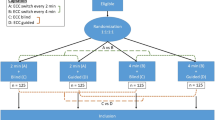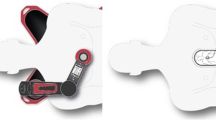Abstract
During cardiopulmonary resuscitation (CPR), the need to interrupt chest compressions to provide synchronous ventilations prevents blood flow continuity, reducing the possibility to ensure high-quality CPR bundles of care and, thus, having a potentially negative impact on perfusion and patient outcome. Contemporaneous asynchronous chest compressions and ventilations may avoid these potentially negative effects. Only a few studies measured the CPR quality metrics during synchronous and asynchronous CPR modality and its relation to patient outcome. A prospective observational study was conducted on 285 consecutive adult patients with out-of-hospital cardiac arrest treated by EMS teams over a 30-month period. Ventilation rate, chest compression fraction (i.e. cardiac arrest time spent delivering uninterrupted chest compressions compared to total cardiac arrest time) and chest compression rate per minute were collected in real time by defibrillators and analysed through a dedicated software (electrical cardiac activity through the ECG, chest compression and ventilations through the transthoracic impedance) during synchronous and asynchronous CPR modalities. During asynchronous CPR modality, higher ventilation rate and chest compression fraction (p < 0.001), and lower chest compression rate per minute (p < 0.001) were ensured, being all cited metrics more adherent to the high-quality CPR bundles. Ventilation rate provided during the whole CPR was an independent predictor for a good neurological outcome (OR 3.795, p = 0.005). Asynchronous chest compression and ventilation ensured the most adequate chest compression fraction, uninterrupted chest compression rate and ventilation rate.


Similar content being viewed by others
References
Sasson C, Rogers MA, Dahl J, Kellermann AL (2010) Predictors of survival from out-of-hospital cardiac arrest: a systematic review and meta-analysis. Circ Cardiovasc Qual Outcomes 3(1):63–81. https://doi.org/10.1161/circoutcomes.109.889576
Monsieurs KG, Nolan JP, Bossaert LL, Greif R, Maconochie IK, Nikolaou NI, Perkins GD, Soar J, Truhlar A, Wyllie J, Zideman DA (2015) European resuscitation council guidelines for resuscitation 2015: section 1. Executive summary. Resuscitation 95:1–80. https://doi.org/10.1016/j.resuscitation.2015.07.038
Neumar RW, Shuster M, Callaway CW, Gent LM, Atkins DL, Bhanji F, Brooks SC, de Caen AR, Donnino MW, Ferrer JM, Kleinman ME, Kronick SL, Lavonas EJ, Link MS, Mancini ME, Morrison LJ, O'Connor RE, Samson RA, Schexnayder SM, Singletary EM, Sinz EH, Travers AH, Wyckoff MH, Hazinski MF (2015) Part 1: executive summary: 2015 american heart association guidelines update for cardiopulmonary resuscitation and emergency cardiovascular care. Circulation 132(18 Suppl 2):S315–367. https://doi.org/10.1161/cir.0000000000000252
Wik L, Olsen J-A, Persse D, Sterz F, Lozano M Jr, Brouwer MA, Westfall M, Souders CM, Travis DT, Herken UR, Lerner EB (2016) Why do some studies find that CPR fraction is not a predictor of survival? Resuscitation 104:59–62. https://doi.org/10.1016/j.resuscitation.2016.04.013
Meaney PA, Bobrow BJ, Mancini ME, Christenson J, de Caen AR, Bhanji F, Abella BS, Kleinman ME, Edelson DP, Berg RA, Aufderheide TP, Menon V, Leary M (2013) Cardiopulmonary resuscitation quality: improving cardiac resuscitation outcomes both inside and outside the hospital: a consensus statement from the American Heart Association. Circulation 128(4):417–435. https://doi.org/10.1161/CIR.0b013e31829d8654
Wik L, Kramer-Johansen J, Myklebust H, Sorebo H, Svensson L, Fellows B, Steen PA (2005) Quality of cardiopulmonary resuscitation during out-of-hospital cardiac arrest. JAMA 293(3):299–304. https://doi.org/10.1001/jama.293.3.299
Kurz MC, Prince DK, Christenson J, Carlson J, Stub D, Cheskes S, Lin S, Aziz M, Austin M, Vaillancourt C, Colvin J, Wang HE (2016) Association of advanced airway device with chest compression fraction during out-of-hospital cardiopulmonary arrest. Resuscitation 98:35–40. https://doi.org/10.1016/j.resuscitation.2015.10.011
Nielsen N, Wetterslev J, Cronberg T, Erlinge D, Gasche Y, Hassager C, Horn J, Hovdenes J, Kjaergaard J, Kuiper M (2013) Targeted temperature management at 33 °C versus 36 °C after cardiac arrest. N Engl J Med 369(23):2197–2206
Ristagno G, Semeraro F, Radeschi G, Pellis T, Gordini G, Ferro S, Cerchiari E (2014) The “Italian Registry of Cardiac Arrest—RIAC”, a national achievement to portrait the italian reality and to contribute to the wider European vision by “EuReCa”. Resuscitation 85(12):e193–e194. https://doi.org/10.1016/j.resuscitation.2014.09.015
Stecher FS, Olsen JA, Stickney RE, Wik L (2008) Transthoracic impedance used to evaluate performance of cardiopulmonary resuscitation during out of hospital cardiac arrest. Resuscitation 79(3):432–437. https://doi.org/10.1016/j.resuscitation.2008.08.007
Perkins GD, Jacobs IG, Nadkarni VM, Berg RA, Bhanji F, Biarent D, Bossaert LL, Brett SJ, Chamberlain D, de Caen AR, Deakin CD, Finn JC, Grasner JT, Hazinski MF, Iwami T, Koster RW, Lim SH, Ma MH, McNally BF, Morley PT, Morrison LJ, Monsieurs KG, Montgomery W, Nichol G, Okada K, Ong ME, Travers AH, Nolan JP (2015) Cardiac arrest and cardiopulmonary resuscitation outcome reports: update of the Utstein Resuscitation Registry Templates for out-of-hospital cardiac arrest. Resuscitation 96:328–340. https://doi.org/10.1016/j.resuscitation.2014.11.002
Ruiz J, Alonso E, Aramendi E, Kramer-Johansen J, Eftestol T, Ayala U, Gonzalez-Otero D (2013) Reliable extraction of the circulation component in the thoracic impedance measured by defibrillation pads. Resuscitation 84(10):1345–1352. https://doi.org/10.1016/j.resuscitation.2013.05.020
Nordseth T, Bergum D, Edelson DP, Olasveengen TM, Eftestol T, Wiseth R, Abella BS, Skogvoll E (2013) Clinical state transitions during advanced life support (ALS) in in-hospital cardiac arrest. Resuscitation 84(9):1238–1244. https://doi.org/10.1016/j.resuscitation.2013.04.010
Skogvoll E, Eftestol T, Gundersen K, Kvaloy JT, Kramer-Johansen J, Olasveengen TM, Steen PA (2008) Dynamics and state transitions during resuscitation in out-of-hospital cardiac arrest. Resuscitation 78(1):30–37. https://doi.org/10.1016/j.resuscitation.2008.02.015
Kramer-Johansen J, Edelson DP, Losert H, Kohler K, Abella BS (2007) Uniform reporting of measured quality of cardiopulmonary resuscitation (CPR). Resuscitation 74(3):406–417. https://doi.org/10.1016/j.resuscitation.2007.01.024
Stickney R, Marx R, Olsufka M, Doherty A, McMahon M, Walker C, O'Grady S (2005) Accurate measurement of chest compressions from thoracic impedance signals. Circulation 112(17):II-326
Losert H, Risdal M, Sterz F, Nysaether J, Kohler K, Eftestol T, Wandaller C, Myklebust H, Uray T, Sodeck G, Laggner AN (2006) Thoracic impedance changes measured via defibrillator pads can monitor ventilation in critically ill patients and during cardiopulmonary resuscitation. Crit Care Med 34(9):2399–2405. https://doi.org/10.1097/01.ccm.0000235666.40378.60
Chamberlain D (2010) Predictors of survival from out-of-hospital cardiac arrest. Heart 96(22):1785–1786. https://doi.org/10.1136/hrt.2010.207076
Nolan JP, Soar J, Wenzel V, Paal P (2012) Cardiopulmonary resuscitation and management of cardiac arrest. Nat Rev Cardiol 9(9):499–511. https://doi.org/10.1038/nrcardio.2012.78
Stub D, Nehme Z, Bernard S, Lijovic M, Kaye DM, Smith K (2014) Exploring which patients without return of spontaneous circulation following ventricular fibrillation out-of-hospital cardiac arrest should be transported to hospital? Resuscitation 85(3):326–331. https://doi.org/10.1016/j.resuscitation.2013.12.010
Jarman AF, Hopkins CL, Hansen JN, Brown JR, Burk C, Youngquist ST (2017) Advanced airway type and its association with chest compression interruptions during out-of-hospital cardiac arrest resuscitation attempts. Prehosp Emerg Care 21(5):628–635. https://doi.org/10.1080/10903127.2017.1308611
Yannopoulos D, Aufderheide TP, Abella BS, Duval S, Frascone RJ, Goodloe JM, Mahoney BD, Nadkarni VM, Halperin HR, O'Connor R, Idris AH, Becker LB, Pepe PE (2015) Quality of CPR: an important effect modifier in cardiac arrest clinical outcomes and intervention effectiveness trials. Resuscitation 94:106–113. https://doi.org/10.1016/j.resuscitation.2015.06.004
Christenson J, Andrusiek D, Everson-Stewart S, Kudenchuk P, Hostler D, Powell J, Callaway CW, Bishop D, Vaillancourt C, Davis D, Aufderheide TP, Idris A, Stouffer JA, Stiell I, Berg R (2009) Chest compression fraction determines survival in patients with out-of-hospital ventricular fibrillation. Circulation 120(13):1241–1247. https://doi.org/10.1161/circulationaha.109.852202
Krarup NH, Terkelsen CJ, Johnsen SP, Clemmensen P, Olivecrona GK, Hansen TM, Trautner S, Lassen JF (2011) Quality of cardiopulmonary resuscitation in out-of-hospital cardiac arrest is hampered by interruptions in chest compressions—a nationwide prospective feasibility study. Resuscitation 82(3):263–269. https://doi.org/10.1016/j.resuscitation.2010.11.003
Olasveengen TM, Vik E, Kuzovlev A, Sunde K (2009) Effect of implementation of new resuscitation guidelines on quality of cardiopulmonary resuscitation and survival. Resuscitation 80(4):407–411. https://doi.org/10.1016/j.resuscitation.2008.12.005
Sayre MR, Cantrell SA, White LJ, Hiestand BC, Keseg DP, Koser S (2009) Impact of the 2005 american heart association cardiopulmonary resuscitation and emergency cardiovascular care guidelines on out-of-hospital cardiac arrest survival. Prehosp Emerg Care 13(4):469–477. https://doi.org/10.1080/10903120903144965
Cheskes S, Schmicker RH, Verbeek PR, Salcido DD, Brown SP, Brooks S, Menegazzi JJ, Vaillancourt C, Powell J, May S, Berg RA, Sell R, Idris A, Kampp M, Schmidt T, Christenson J (2014) The impact of peri-shock pause on survival from out-of-hospital shockable cardiac arrest during the resuscitation outcomes consortium primed trial. Resuscitation 85(3):336–342. https://doi.org/10.1016/j.resuscitation.2013.10.014
Vaillancourt C, Everson-Stewart S, Christenson J, Andrusiek D, Powell J, Nichol G, Cheskes S, Aufderheide TP, Berg R, Stiell IG (2011) The impact of increased chest compression fraction on return of spontaneous circulation for out-of-hospital cardiac arrest patients not in ventricular fibrillation. Resuscitation 82(12):1501–1507. https://doi.org/10.1016/j.resuscitation.2011.07.011
Idris AH, Guffey D, Aufderheide TP, Brown S, Morrison LJ, Nichols P, Powell J, Daya M, Bigham BL, Atkins DL, Berg R, Davis D, Stiell I, Sopko G, Nichol G (2012) Relationship between chest compression rates and outcomes from cardiac arrest. Circulation 125(24):3004–3012. https://doi.org/10.1161/circulationaha.111.059535
Odegaard S, Pillgram M, Berg NE, Olasveengen T, Kramer-Johansen J (2008) Time used for ventilation in two-rescuer CPR with a bag-valve-mask device during out-of-hospital cardiac arrest. Resuscitation 77(1):57–62. https://doi.org/10.1016/j.resuscitation.2007.11.005
Cordioli RL, Brochard L, Suppan L, Lyazidi A, Templier F, Khoury A, Delisle S, Savary D, Richard JC (2018) How ventilation is delivered during cardiopulmonary resuscitation: an international survey. Respir Care 63(10):1293–1301. https://doi.org/10.4187/respcare.05964
Lurie KG, Yannopoulos D, McKnite SH, Herman ML, Idris AH, Nadkarni VM, Tang W, Gabrielli A, Barnes TA, Metzger AK (2008) Comparison of a 10-breaths-per-minute versus a 2-breaths-per-minute strategy during cardiopulmonary resuscitation in a porcine model of cardiac arrest. Respir Care 53(7):862–870
Handley AJ (2015) To ventilate or not to ventilate? That is the question—again. Resuscitation 91:A11–12. https://doi.org/10.1016/j.resuscitation.2015.03.019
Seethala RR, Abella BS (2010) To ventilate or not to ventilate during cardiopulmonary resuscitation: that is the question. Heart 96(8):577–578. https://doi.org/10.1136/hrt.2009.183756
Aufderheide TP (2006) The problem with and benefit of ventilations: should our approach be the same in cardiac and respiratory arrest? Curr Opin Crit Care 12(3):207–212. https://doi.org/10.1097/01.ccx.0000224863.55711.56
McDannold R, Bobrow BJ, Chikani V, Silver A, Spaite DW, Vadeboncoeur T (2018) Quantification of ventilation volumes produced by compressions during emergency department cardiopulmonary resuscitation. Am J Emerg Med 36(9):1640–1644. https://doi.org/10.1016/j.ajem.2018.06.057
Fouche PF, Simpson PM, Bendall J, Thomas RE, Cone DC, Doi SA (2014) Airways in out-of-hospital cardiac arrest: systematic review and meta-analysis. Prehosp Emerg Care 18(2):244–256. https://doi.org/10.3109/10903127.2013.831509
Hasegawa K, Hiraide A, Chang Y, Brown DF (2013) Association of prehospital advanced airway management with neurologic outcome and survival in patients with out-of-hospital cardiac arrest. JAMA 309(3):257–266. https://doi.org/10.1001/jama.2012.187612
McMullan J, Gerecht R, Bonomo J, Robb R, McNally B, Donnelly J, Wang HE (2014) Airway management and out-of-hospital cardiac arrest outcome in the CARES registry. Resuscitation 85(5):617–622. https://doi.org/10.1016/j.resuscitation.2014.02.007
Jabre P, Penaloza A, Pinero D et al (2018) Effect of bag-mask ventilation vs endotracheal intubation during cardiopulmonary resuscitation on neurological outcome after out-of-hospital cardiorespiratory arrest: a randomized clinical trial. JAMA 319(8):779–787. https://doi.org/10.1001/jama.2018.0156
Nichol G, Leroux B, Wang H, Callaway CW, Sopko G, Weisfeldt M, Stiell I, Morrison LJ, Aufderheide TP, Cheskes S, Christenson J, Kudenchuk P, Vaillancourt C, Rea TD, Idris AH, Colella R, Isaacs M, Straight R, Stephens S, Richardson J, Condle J, Schmicker RH, Egan D, May S, Ornato JP (2015) Trial of continuous or interrupted chest compressions during CPR. N Engl J Med 373(23):2203–2214. https://doi.org/10.1056/NEJMoa1509139
Acknowledgements
The authors thank the whole staff of the Emergency Medical Service and the Cardiovascular Department of Trieste University Hospital for their collaboration.
Funding
This research did not receive any specific grant from funding agencies in the public, commercial, or not-for-profit sectors.
Author information
Authors and Affiliations
Corresponding author
Ethics declarations
Conflict of interest
The authors declare that they have no conflict of interest.
Statement of human and animal rights
This research conforms with the principles outlined in the Declaration of Helsinki. The study was approved by the Institutional Ethical Committee as a part of the Italian Registry of Cardiac Arrest-RIAC study.
Informed consent
For survived patients admitted to the hospital, consent was managed following institutional procedures, providing that patients or her/his legal representative authorized the use of their clinical data for research purposes.
Additional information
Publisher's Note
Springer Nature remains neutral with regard to jurisdictional claims in published maps and institutional affiliations.
Rights and permissions
About this article
Cite this article
Sanson, G., Ristagno, G., Caggegi, G.D. et al. Impact of ‘synchronous’ and ‘asynchronous’ CPR modality on quality bundles and outcome in out-of-hospital cardiac arrest patients. Intern Emerg Med 14, 1129–1137 (2019). https://doi.org/10.1007/s11739-019-02138-9
Received:
Accepted:
Published:
Issue Date:
DOI: https://doi.org/10.1007/s11739-019-02138-9




